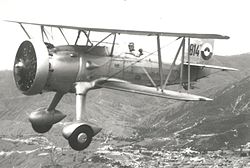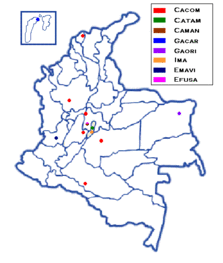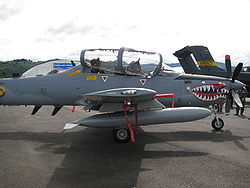- Colombian Air Force
-
Colombian Air Force 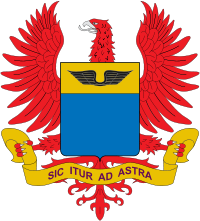
Coat of arms of the Colombian Air ForceFounded December 31, 1919 Country Colombia Branch Air Force Size 13,500 active personnel [1] Part of Colombian Armed Forces Motto Sic Itur Ad Astra - "Thus one reaches the stars" Anniversaries November 8 Engagements Colombia–Peru War
Colombian armed conflictCommanders Current
commanderGeneral Jorge Ballesteros Rodriguez Second Commander and Mayor Chief of Staff General Fernando Soler Torres Notable
commandersGeneral Hector Fabio Velasco Insignia Roundel 
Aircraft flown Attack A-29, A-37, OV-10, AC-47 Fighter IAI Kfir, Mirage 5 Attack helicopter AH-60, AB212 Rápaz Reconnaissance Schweizer SA 2-37 Trainer T-34, T-41, T-27 Transport C-130, C-295, CN-235, C-212 The Colombian Air Force or FAC (Spanish: Fuerza Aérea Colombiana) is the Air Force of the Republic of Colombia. The Colombian Air Force (FAC) is one of the three institutions of the Armed Forces of Colombia, charge according to the 1991 Constitution of the work to exercise and maintain control of Colombia's airspace to defend the sovereignty, territorial integrity and constitutional order. It is one of the largest Latin American air forces and increased activity due to its important role in the fight against narco-terrorism.
Air Force is the only global processes that have accredited with ISO 9001 and NTCGP 1000. The system corresponds to ISO 9001 quality management with the international standard, which inscribed the FAC as a world-class organization. The second certificate, the NTCGP 1000, corresponds to the technical standard of quality of governance, as a result of Act 872 of 2003 requires all public bodies to implement the quality management system by December 2008.
The FAC has the distinction of having been used in missions of observation and aerial combat from the Colombian-Peruvian war of 1932, never elected government was ousted by force, as the FAC helped quell many rebellions from terrorism, military and political . The Colombian Air Force also served with distinction during the Second World War in the islands of San Andrés.
Contents
History
Creation
Military aviation began in Colombia in 1919 with the creation of a military aviation school for the Colombian Army. Previously by Law 15 of 1916 of September 7 two commissions were sent overseas to study new technological advancements in aviation, infantry, cavalry, engineering and trains. Officers pertaining to the Colombian Army were also sent to take a course on flight training on techniques and tactics. The school was then created in Colombia along with the Colombian National Army Aviation as a fifth regiment by Law 126 of 1919 of December 31 authorized by President of Colombia, Marco Fidel Suárez. The unit was officially activated on February 15, 1921 in Flandes, Department of Tolima with the support of a French mission led by Lieutenant Colonel Rene Guichard. The Aviation School initially had 3 Caudron G.3 E-2, 3 Caudron G.4 A-2 and four Nieuport Delage 11 C-1. The school was closed due to financial hardships in 1922.
The School of Military Aviation was reopened on November 8, 1924 in Madrid, Department of Cundinamarca with the support of a Swiss mission headed by Captain Henry Pillichody. The aircraft used for training were 4 Wild WT and 8 Wild X performing the first air review on August 7, 1927. Then on December 28, 1928 the first combat aircraft was shown in Colombia, the Curtiss Falcon O-1.
War with Peru
See also: Colombia-Peru WarOn September 1, 1932 civilian Peruvians illegally crossed into Colombian territory and invaded the town of Leticia in the Colombian Amazon arguing and claiming that the town was original Peruvian territory. The Colombian military aviation only had 11 instructors, four Curtiss-Wright CW-14R Osprey air combat support planes and one Curtiss Falcon O-1. The military aviation then received full financial support from the Congress of Colombia. Colombia bought aircraft from Germany and the United States, while others were activated from the airline operating in Colombia SCADTA (Sociedad Colombo-Alemana de Transporte Aéreo) and their pilots, which included some German citizens, one of these was Major Herbert Boy. The imported aircraft were 4 Junkers F.13, 4 Junkers W 34 and 3 Junkers K 43, 6 Junkers Ju 52, 2 Dornier Merkur II, 4 Dornier Wal, 20 Curtiss Falcon F-8F and 30 Curtiss Hawk II F-11C.
The contingent was then sent to southern Colombia to fight Peruvian forces with the main mission of delivering supplies to the front lines, aerial reconnaissance and air to land attacks. The fleet was divided into three squadrons with Puerto Boy as the main camp site. Support bases were in Caucaya airstrip (Puerto Leguízamo), El Encanto, Puerto Arica, La Pedrera and Tarapacá. The main combat operations started on February 14, 1933 in Tarapacá where the Peruvian garrison was bombed by seven Colombian aircraft and later assaulted by land forces. Later, on March 26, in the village of Guepi eleven Colombian planes and two cannon boats (MC Cartagena y MC Santa Marta) bombarded Peruvian positions and took over the town.
The last military actions of the conflict with Peru were on May 8, 1933 and in which there was an aerial engagement between the two forces. Peruvian planes were attacking the fluvial fleet of Colombia over the Algodón River and were surprised by the Colombian squadron. One of the Peruvian aircraft, a Douglas O-38P was gunned down and taken to Colombian territory. On May 24, 1933 a cease fire was declared after an agreement was reached with the intervention of the League of Nations. The town of Leticia was returned to Colombia. The captured plane was then returned to Peru. As a result of the war, four pilots died in four accidents during non-combat related actions. Among these was one of the German pilots. Four planes were lost in these accidents a Falcon O-1, an Osprey C-14, a Junker F-13 and a Curtiss F-11.
World War II
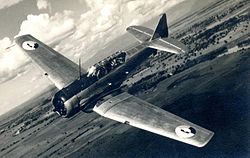 The AT-6 Texan U.S. origin served as a support during the Second World War, defending the country's Caribbean coast
The AT-6 Texan U.S. origin served as a support during the Second World War, defending the country's Caribbean coast
The Second World War was the diplomatic breach between Colombia and the Axis countries (Germany, Italy and Japan), December 18, 1941, when President Eduardo Santos took the decision following the Japanese attack on military bases, naval and U.S. carriers at Pearl Harbor, Hawaii. Thereafter, the Colombian government introduced special measures to limit and counter the Axis military action in areas of national jurisdiction. However, the June 23, 1942 a German submarine attacked and sank the schooner Colombian "Resolute", 50 miles northwest of the island of San Andrés. The same schooner had rescued some Marine officers and 23 British Royal Navy survivors of a capsized ship, 200 miles north of Cartagena just five days before.
Following these events, the government took the decision to patrol and monitor the Pacific Coast and the Colombian Caribbean coast. The Palanquero Air Base commanders decided to move one fighter squadron and a Combat Reconnaissance Squadron, consisting of F-8 Falcon aircraft, to Barranquilla,. In 1943, the Falcons were relieved of their mission and replaced by the AT-6 Texan. This Squadron was active until 1945, when the AT-6 were transferred back to Palanquero Air Base.
Early 1930s to present
- In 1935 the first combat monoplanes made of aluminum were purchased by the Colombian Air Force; 4 Seversky P-35/2PA Guardsman.
- While the war was ongoing in southern Colombia, the Air Force built bases in the towns of Buenaventura and Cartagena. The base in Buenaventura was dubbed Air Base of the Pacific and covered the area of the Colombian Pacific region by the Pacific Ocean and began operations on January 26, 1933. The main purpose of this base was to protect the Pacific coast from any maritime intervention since there were reports that the Peruvian protected cruiser BAP Almirante Grau was patrolling the area, as well as two submarines. The Buenaventura base closed in 1949 while the base in Cartagena was handed over to the Colombian Navy in 1936 becoming the ARC Bolívar Naval Base, the most important naval base in Colombia.
- Once the conflict with Peru was over the bases in the Amazon basin were dismantled and the troops sent to new bases like Tres Esquinas Air Force Base in the Department of Caqueta, Palanquero Air Force Base in the Department of Cundinamarca and San José del Guaviare in the Department of Guaviare. Meanwhile the School of Military Aviation was moved to Cali, and leaving in Madrid the Radiotelegraphy and Maintenance Schools.
- During World War II, North American T-6 Texans and Boeing PT-17 Stearmans were received from the USA for pilot training. Soon after World War Two, the Aviación Militar became an independent part of the armed forces, and the Colombian Air Force was created.
- During the period of La Violencia, The Air Force had the necessity to expand its radius of action, so in 1947 the aeródromo nacional de Apiay was created, named the 17 of November 1948 Base Aérea de Apiay, today it home of the Comando Aéreo de Combate No. 2. In this period, the Air Force became more involved in counterinsurgency tasks and B-26C Invaders were acquired. Also, in 1954, the jet age began for the Colombian Air Force with the arrival of Silver Star T-33 and six Canadian Sabre Mark IV F-86. The F-86 were retired from service 1966, while the T-33 continued to operate until 1972 when 18 Mirage 5 fighters arrived in three different versions. Sixteen F-80 Shooting Stars were also delivered.
- In 1952, Hiller UH-12 helicopters arrived to the country, initially acquired for the Ministerio de Obras Públicas, but later assigned to the Air Force. In consequence, in 1954, the first helicopter base was created in Melgar, Tolima. Nowadays this base is known as Base Aérea “Capitán Luis F. Gómez Niño”, home of the Comando Aéreo de Combate No. 4 and the Joint Helicopter School of the Armed Forces. In 1959, with the inauguration of the El Dorado International Airport, the Base Aérea de Transporte Militar was created, later renamed as Base Aérea “Brigadier General Camilo Daza”, home today of the Comando Aéreo de Transporte Militar (CATAM). In 1962 in order to integrate economically and socially the furthest regions of the country the Servicio Aéreo a Territorios Nacionales Satena was created.
- Around 1960 the military transport element expanded, with the acquisition of the C-130 Hercules, other types incorporated during the sixties were, the UH-1 Huey, T-37 Tweet and T-41 Mescalero.
- In 1977, to increase control in the northern part of the country, the Grupo Aéreo del Norte was created in Malambo, Atlántico, home today of the Comando Aéreo de Combate No. 3. In 1979, the Grupo Aéreo del Caribe (GACAR) was created, to defend the sovereignty of San Andrés and Providencia from the pretensions of Nicaragua. In 1983, the Grupo Aéreo de Oriente was created in Marandúa, Vichada to exert more control of the airspace in the eastern part of the country.
- Further expansion took place in the eighties with considerable deliveries of the A-37 Dragonfly, which earned fame over Vietnam. At the end of the decade a batch of Kfir C2 fighters was delivered from Israel and subsequently upgraded to Kfir C7 by the Comando Aéreo de Mantenimiento (CAMAN) in Madrid in the nineties. The Mirages were upgraded to the same standard by CAMAN, with the installation of canards and improved fuel systems. Both types are also equipped for air-to-air refuelling from the FAC's sole Boeing 707 tanker and transport aircraft. The nineties saw the delivery of specialised COIN-aircraft like the OV-10A Bronco and Embraer Tucano trainers, some of the latter are able to carry bombs and unguided rockets. These aircraft operate mainly over the east of the country, where the Los Llanos region has a high level of guerrilla activity. They regularly deploy to Puerto Carreño under the command of the Grupo Aéreo del Oriente formed in 2000. To deal with continuing guerrilla activity Escuadrones Aerotácticos (tactical squadrons) were formed at the main FAC bases in the late nineties, consisting of several types of helicopters and AC-47 gunships supplied by their respective Grupos.
- Finally in 1990 the Base Aérea de Rionegro, Antioquia is activated, center of operations of the UH-60 Black Hawk, today this base is called Comando Aéreo de Combate No. 5.
- The 1999 'Plan Colombia' emphasizes on technology, rather than on large numbers of new aircraft being procured, although several new UH-60 Black Hawk helicopters (dubbed Arpía in Colombian service) entered FAC service in recent years. Other recently acquired types include Schweizer SA2-37A Condors and Cessna 560 Citations equipped with cameras and sensors to monitor guerrilla and narcotic related activities. Technology upgrades are scheduled for the Bronco fleet, the venerable AC-47 gunships and Huey-helicopters.
Organization
Combat Air Commands (Comando Aéreo de Combate or CACOM):
-
Comando Aéreo de Combate No. 1 (CACOM 1) "CT. Germán Olano Moreno"
in Palanquero / Puerto Salgar, Cundinamarca [2][3]- Grupo de combate Nº 11
- Escuadrón de Combate 111 Dardos (Kfir C7, Kfir TC7)
- Escuadrón de Combate 112 Mirage (Mirage 5COAM, Mirage 5CODM)
- Escuadrón de Combate Táctico 113 Fantasma (AB212 Rapáz, AC-47T Fantasma, AH-60L Arpía III)
- Escuadrón de Combate 116 Tango (T-37B, T-37C)
- Grupo de combate Nº 11
-
Comando Aéreo de Combate No. 2 (CACOM 2) "CT. Luis Fernando Gómez Niño"
in Apiay / Villavicencio, Meta [4][5]- Grupo de Combate Nº 21
- Escuadrón de Combate 211 Grifos (A-29B Supertucano)
- Escuadrón de Combate 212 Tucanos (AT-27 Tucano)
- Escuadrón de Combate Táctico 213 (AH-60L Arpía III, C212-300, C208-675, SA2-37B Vampiro, SR-560)
- Grupo de Combate Nº 22 located in Yopal, Casanare.
- Escuadrón de Combate 221 Bronco (North American OV-10 Bronco)
- Grupo de Combate Nº 21
-
Comando Aéreo de Combate No. 3 (CACOM 3) "MG. Alberto Pauwels Rodríguez"
in Malambo / Barranquilla, Atlántico [6][7]- Grupo de Combate 31
- Escuadrón de Combate 311 Dragones (A-37 Dragonfly).
- Escuadrón de Combate 312 Drakos (A-29B Supertucano).
- Escuadrón de Combate Táctico 313 (AC-47T Fantasma, Bell 212 Rapáz, C-95A, SA2-37B Vampiro, SR-26B Tracker, UH-1 Huey II).
- Grupo de Combate 31
-
Comando Aéreo de Combate No. 4 (CACOM 4) "TC. Luis Francisco Pinto Parra"
in Melgar, Tolima [8][9]- Grupo de Combate 41
- Escuadrón de Combate 411 Rapaz (Bell 212).
- Escuadrón de Asalto Aéreo 412 (Bell UH-1H/P).
- Eccuadron de Ataque 413 Escorpion (MD 500/530).
- Grupo CSAR.
- Escuela de Helicópteros de las Fuerzas Armadas.
- Escuadrón de Vuelo (Bell UH-1H, Bell 206, Bell OH-58 Kiowa).
- Grupo de Combate 41
-
Comando Aéreo de Combate No. 5 (CACOM 5) "GR. Arturo Lema Posada"
in Rionegro, Antioquia [10][11]- Grupo de Combate 51
- Escuadrón de Combate 511 (AH-60L Arpía III)
- Escuadrón de Operaciones Especiales 512 (Ce208-675, UH-60A Halcon, UH-60L Halcon)
- Grupo de Combate 51
-
Comando Aéreo de Combate No. 6 (CACOM 6) "CT. Ernesto Esguerra Cubides"
in Tres Esquinas, Caquetá [12][13]- Grupo de Combate 61
- Escuadrón de Combate 611 (AT-27 Tucano, A-29B Supertucano)
- Escuadrón de Combate Táctico 613 (AC-47T Fantasma, Bell 212 Rapaz, C212-300, SA2-37B Vampiro, UH-1H-II, Scan Eagle UAV)
- Grupo de Combate 61
Transportation and Maintenance:
-
Comando Aéreo de Transporte Militar (CATAM) "BG. Camilo Daza Álvarez"
in Bogotá D.C.[14][15]- Grupo de Transporte Aéreo 81
- Escuadrón de Transporte 811 (C-130B, C-130H, C-130H-1, C295M, CN235M-100)
- Escuadron de Evacuación Medica.
- Grupo de Vuelos Especiales 82
- Escuadrón de Transporte Especial 821 (B707-323C, B737-74V, Beech 300 ELINT, Beech 350, Bell 412HP, C-95A, Ce208B, Ce550, F28-3000(C), PA-42-720, PA-42T, RC690D, RC695)
- Grupo de Transporte Aéreo 81
-
Comando Aéreo de Mantenimiento (CAMAN) "MY. Justino Mariño Cuesto"
in Madrid, Cundinamarca [16][17]- Grupo de Transporte Aéreo 91
- Escuadrón de Transporte 911 (Beech C90, C212-300)
- Grupo de Transporte Aéreo 91
Air Groups:
-
Grupo Aéreo del Caribe (GACAR) "TC. Benjamín Méndez Rey"
on San Andres Island, San Andrés, Providencia y Santa Catalina [18][19]- Escuadrón de Combate 101
- Escuadrilla de Combate Táctico 1013 (Beech C90)
- Escuadrón de Combate 101
-
Grupo Aéreo del Oriente (GAORI) "CR. Luis Arturo Rodríguez Meneses"
in Marandúa, Vichada [20][21]- Grupo de Combate 111
- Escuadrilla de Combate Táctico 1113 (AC-47T Fantasma, AB212 Rapaz, UH-1H-II, Scan Eagle UAV)
- Grupo de Combate 111
Training:
-
Escuela Militar de Aviación (EMAVI) "Marco Fidel Suárez"
in Santiago de Cali, Valle del Cauca [22][23]- Grupo de Educación Aeronáutica
- Escuadrón Básico
- Grupo de Combate 71
- Escuadrón de Combate Táctico 713
- Grupo de Educación Aeronáutica
-
Escuela de Suboficiales FAC (ESUFA) "CT. Andrés Maria Díaz Díaz"
in Madrid, Cundinamarca [24][25]
Airline:
Personnel
As of 2010 [1], the Air Force fields approximately 13,500 personnel, including 2,171 officers, 3,304 Non-commissioned officers, 903 student officers, 4,673 soldiers, these usually allocated to base security, Military Police etc, and 2,382 civilians, the latter usually dedicated to specialized technical or professional activities, eg, medical, communications, etc.
Ranks & Insignias
Further information: Military ranks of the Colombian Armed ForcesThe tables below display the rank structures and rank insignias for the Colombian Air Force personnel.[27]
Ranks and Insignias - Colombian Air Force Officers
NATO code [n 1] OF-10 OF-9 OF-8 OF-7 OF-6 OF-5 OF-4 OF-3 OF-2 OF-1  Colombia
ColombiaNo Equivalent 









(Spanish) - General del Aire Teniente General del Aire Mayor General del Aire Brigadier General del Aire Coronel Teniente Coronel Mayor Capitán Teniente Subteniente Abbr. - GR TG MG BG CR TC MY CT TE ST (English) - General of the Air Lieutenant General of the Air Major General of the Air Brigadier General of the Air Colonel Lieutenant Colonel Major Captain Lieutenant Second Lieutenant Non-Commissioned Officers and Airmen
NATO code [n 1] OR-9 OR-8 OR-7 OR-6 OR-5 OR-4 OR-3 OR-2 OR-1  Colombia
Colombia








No equivalent (Spanish) Técnico Jefe de Comando Conjunto Técnico Jefe de Comando Técnico Jefe Técnico Subjefe Técnico Primero Técnico Segundo Técnico Tercero Técnico Cuarto Aerotécnico - Abbr. TJCC TJC TJ TS TP T2 T3 T4 AT - (English) Joint Command Chief Technician Command Chief Technician Senior Chief Technician Chief Technician Technician First Class Technician 2nd Class Technician 3rd Class Junior Technician Airman - Aircraft inventory
Aircraft Origin Type Versions In service Notes Combat aircraft IAI Kfir  Israel
IsraelFighter/attack C.12, TC.12 /C.10, TC.10 (in Colombia denominated "Kfir COA") 24 Embraer EMB-314 Super Tucano  Brazil
BrazilCombat 25 North American OV-10 Bronco  United States
United StatesCombat/Counter Insurgency 6 AC-47 Spooky  United States
United StatesCombat/Counter Insurgency 6 Locally known as Fantasmas (Ghost) A-37 Dragonfly  United States
United StatesCombat/Counter Insurgency 32 13 Currently in Service Total Combat Aircraft 93 Trainers Cessna T-41 Mescalero  United States
United StatesTrainer T-41D 10 Beechcraft T-34 Mentor  United States
United StatesTrainer T-34M 10 Cessna T-37 Tweet  United States
United StatesTrainer T-37B Tweet/T-37C Tweet 14 Embraer Tucano  Brazil
BrazilAttack/Trainer AT-27 14 Total Trainer Air Craft 34 Transports Beechcraft Queen Air  United States
United StatesUtility transport 65-B80 2 Beechcraft Twin Bonanza  United States
United StatesUtility transport D50 1 Boeing 707  United States
United StatesTransport Tanker 707-373C 1 Boeing 767  United States
United StatesTransport Tanker KC-767 1 Boeing Business Jet  United States
United StatesVIP transport BBJ1 1 Fokker F28  Netherlands
NetherlandsVIP transport F28-1000/F28-3000 2 Cessna Citation II  United States
United StatesVIP transport 550 Citation II 1 CASA C-212 Aviocar  Spain
SpainTactical transport C-212-300 3 CASA CN-235  Spain
SpainTactical transport CN-235-200 3 EADS CASA C-295  Spain
SpainTactical transport C-95M 4 Embraer EMB 110 Bandeirante  Brazil
BrazilTransport EMB 110P1A 2 Gavilan 358  Colombia
ColombiaUtility transport 4 IAI Arava  Israel
IsraelUtility transport Arava 201 1 C-130 Hercules  United States
United StatesTactical transport C-130B/C-13H 7 Piper PA-23 Aztec  United States
United StatesUtility transport 1 Piper PA-31T Cheyenne  United States
United StatesUtility transport 1 Piper PA-34 Seneca  United States
United StatesUtility transport 3 Cessna 208 Caravan  United States
United StatesUtility transport 1 Cessna 208 Caravan  United States
United StatesLiaison 5 Total Transport Air Craft 45 Helicopter Bell 205  United States
United StatesUtility helicopter Model 205 UH-1H/P 26 Bell 212 Twin Huey  United States
United StatesTransport helicopter 12 MD Helicopters MD500 Defender  United States
United StatesCombat helicopter 369HM/MD 530FF 16 Sikorsky UH-60 Black Hawk  United States
United StatesTransport helicopter and Combat helicopter UH-60L/AH-60 Arpía 90 Bell 206  United States
United StatesTrainer helicopter Bell 206B-III 32 Total Transport helicopters/Search and Rescue Helicopters 176 Reconnaissance and Intelligence Schweizer SA 2-37  United States
United Statesreconnaissance 6 Fairchild C-26 Metroliner  United States
United StatesTransport / SIGINT C-26A 5 Cessna CitationJet  United States
United StatesTracker Citation SR-560 6 Cessna O-2  United States
United StatesTracker 2 Beechcraft Super King Air  United States
United StatesELINT Super King Air 300 6 Total Reconnaissance and Intelligense 25 Satena Dornier Do328-100  Germany
GermanyAirliner 33 seats 6 ATR 42-500  France
FranceAirliner 46 seats 2 Embraer ERJ 145  Brazil
BrazilAirliner 50 seats 2 Embraer 170  Brazil
BrazilAirliner 76 seats 2 Total Satena Air Craft 12 Total Air Craft in service Total Air Craft in service 385 FAC is not Colombia's exclusive operator of military aircraft, as smaller inventories are maintained by the Colombian Army, Colombian Navy, and the Colombian National Police.
Aircraft identification
The aircraft used by the Colombian Air Force are identified with the letters "FAC" followed by three or four numbers numbers that are painted on the tail, nose and nose landing gear doors. The serial numbers are assigned according to the aircraft's primary role as follows:
- 001 Avión Presidencial
- 002 to 100 trainer
- 101 to 200 liaison
- 201 to 300 helicopter
- 301 to 500 miscellaneous
- 501 to 600 light transport
- 601 to 700 transport
- 701 to 800 advanced trainer
- 801 to 900 fighter-bomber
- 901 to 1000 crew-trainer
- 1001 to 1300 transport
- 2001 to 2300 Close support
- 2501 to 2600 bomber
- 3001 to 3100 Fighter
- 3101 to 3200 COIN
- 4001 to 4600 helicopter
- 5001 to 5600 liaison
- 5701 to 5800 recon/ELINT
See also
Notes
References
- ^ a b Ministerio de Defensa Nacional,Colombia (1 November 2010). "Logros de la Política de Consolidación de la Seguridad Democrática, 2010" (in (Spanish)). http://www.mindefensa.gov.co/irj/go/km/docs/Mindefensa/Documentos/descargas/estudios%20sectoriales/info_estadistica/Logros%20de%20Politica%20CSD%20Nov%202010.pdf. Retrieved 23 April 2011.
- ^ (Spanish) CACOM 1 - Puerto Salgar (Cundinamarca) - Comando Aéreo de Combate No.1
- ^ (Spanish) Capitán Germán Olano Moreno
- ^ (Spanish) CACOM 2 - Apiay (Meta) - Comando Aéreo de Combate No.2
- ^ (Spanish) Capitán Luis F. Gómez Niño
- ^ (Spanish) CACOM 3 - Malambo (Atlántico) - Comando Aéreo de Combate No.3
- ^ (Spanish) Mayor General Alberto Pauwels Rodríguez
- ^ (Spanish) CACOM 4 - Melgar (Tolima) - Comando Aéreo de Combate No.4
- ^ (Spanish) Teniente Coronel Luis Francisco Pinto Parra
- ^ (Spanish) CACOM 5 - Rionegro (Antioquia) - Comando Aéreo de Combate No.5
- ^ (Spanish) Coronel Fernando Arturo Lema Posada
- ^ (Spanish) CACOM 6 - Tres Esquinas (Caquetá) - Comando Aéreo de Combate No.6
- ^ (Spanish) Capitán Ernesto Esguerra Cubides
- ^ (Spanish) CATAM - Aeropuerto El Dorado (Bogotá D.C) - Comando Aéreo de Transporte Militar
- ^ (Spanish) Brigadier General (H) Camilo Daza Álvarez
- ^ (Spanish) CAMAN - Madrid (Cundinamarca) - Comando Aéreo de Mantenimiento
- ^ (Spanish) Mayor (H) Justino Mariño Cuesto
- ^ (Spanish) GACAR - San Andrés Isla (San Andrés, Providencia y Santa Catalina) - Grupo Aéreo del Caribe
- ^ (Spanish) Teniente Coronel Benjamín Méndez Rey
- ^ (Spanish) GAORI - Marandua (Vichada) - Grupo Aéreo del Oriente
- ^ (Spanish) Coronel Luis Arturo Rodríguez Meneses
- ^ (Spanish) EMAVI - Santiago de Cali (Valle) - Escuela Militar de Aviación
- ^ (Spanish) Marco Fidel Suárez
- ^ (Spanish) ESUFA - Madrid (Cundinamarca) - Escuela de Suboficiales FAC
- ^ (Spanish) Captain Andres Maria Diaz Diaz
- ^ (Spanish) IMA - Instituto Militar Aeronáutico
- ^ Congreso de la República de Colombia (28 July 2010). "Ley 1405 de 2010 Nuevos Grados Militares" (in (Spanish)). http://www.secretariasenado.gov.co/senado/basedoc/ley/2010/ley_1405_2010.html. Retrieved 26 April 2011.
External links
- Air Force Bases in Colombia at GlobalSecurity.org
- (Spanish) Fuerza Aérea Colombiana
- (Spanish) Colombia: Seguridad & Defensa, Unofficial site
- (Spanish) Aviacol.net: History of the Colombian Air Force
- (Spanish) UNFFMM página no oficial de las Fuerzas Militares de Colombia
- (Spanish) Combat aircraft of the FAC, at SAORBATS
Military of Colombia Service Branches 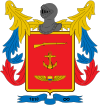
Army 1st Division · 2nd Division · 3rd Division · 4th Division · 5th Division · 6th Division · 7th Division · 8th Division · Airborne Unit · OMEGA · AFEUR · Ranks & Insignias · LanceroNavy Active Ships · Decommissioned Ships · Almirante Padilla Frigate · Type 209 Submarine · ARC Gloria (School /Flagship) · Navy Ranks & Insignias · Marine Infantry Ranks & InsigniasAir Force Ct. German Molano Air Base · Ct. Luis Gomez Air Base · Maj. Alberto Pauwels Rodríguez Air Base · Lt Col. Luis Pinto Air Base · BG Arturo Lema Posada Air Base · Ct.Ernesto Esguerra Air Base · BG. Camilo Daza Álvarez Air Base · My.Justino Marino Air Base · Cl. Luis Rodriguez Air Base · Lt Col. Benjamín Méndez Rey Air Base · Marco Fidel Suárez Air Base (EMAVI) · Ranks & Insignias
Wars and Conflicts Gran Colombia-Peru War · Supremes War · Gran Colombia-Ecuador Conflict · Colombia-Peru War · La Violencia Era · Korean War · Colombian internal conflictRelated dependencies Categories:
Wikimedia Foundation. 2010.

